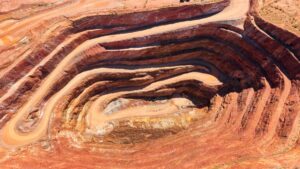Russia’s Game-Changer: The Baimskaya Copper Mine Investment
In a significant move that underscores its commitment to expanding its mineral resource sector, the Russian state bank VEB has pledged an investment exceeding 1.1 trillion rubles (approximately $13.4 billion USD) towards the development of the Baimskaya copper mine, located in the remote Chukotka region. This strategic initiative is designed not just to exploit a valuable natural resource, but to transform the local and national economy in a post-sanction landscape.
Comprehensive Infrastructure Development
The Baimskaya project is much more than just a mining venture; it encompasses the construction of a fully integrated industrial complex. This development includes a processing plant, essential infrastructure like a deepwater port, and a crucial 428-kilometer road designed to facilitate year-round exports of copper, one of the world’s most sought-after industrial metals.
This comprehensive approach is expected to revolutionize the regional economy. With an annual ore processing capacity projected to reach 70 million tonnes, the mine is positioned to produce an average of 300,000 tonnes of copper each year during its initial decade of operation. This output will not only bolster Russia’s standing in the global copper market but is also projected to raise overall copper production by a notable 25% and gold production by 4%.
Job Creation and Economic Boost
The economic ramifications of the Baimskaya copper mine extend far beyond its immediate outputs. General Director of the Baimskaya Management Company, Georgy Fotin, has emphasized that the project is expected to create around 6,000 jobs, directly impacting local unemployment rates and stimulating growth in various sectors related to mining and manufacturing. Moreover, the project is anticipated to yield tax revenues exceeding 3 trillion rubles, providing a substantial boost to local and national coffers.
Chukotka, characterized by its rugged terrain and significant portions above the Arctic Circle, stands to gain immensely from this project, which aligns with broader government initiatives focused on the Social and Economic Development Strategy for the Far East and Baikal Region through 2025, and the Chukotka Autonomous Region through 2030.
A Strategic Economic Zone
President Vladimir Putin has previously underscored the importance of the Arctic as a strategic economic area, especially as Russia shifts its trade focus towards Asia in the wake of Western sanctions. With increased commercial activity expected along the Northern Sea Route (NSR), the development of the Baimskaya deposit is projected to contribute an additional 2 million tonnes of annual cargo traffic to this vital maritime artery.
As global demand for copper surges, partially due to its critical role in renewable energy technologies and electric vehicle components, investments like this one place Russia at the forefront of critical resource extraction needed for a sustainable future.
The Future of Russian Mining
In addition to the Baimskaya project, the Russian Natural Resources Ministry has unveiled plans to produce a minimum of 60,000 tonnes of lithium carbonate by 2030. This initiative further highlights Russia’s desire to reduce dependency on imports and strengthen its capacity for producing high-performance electric batteries, aligning with international trends towards cleaner energy solutions.
The Baimskaya copper mine represents a crucial step in not only revitalizing the Russian mining industry but also reasserting its position in the global market. While it holds the promise of immediate economic benefits, the strategic implications of such an investment could reshape the dynamics of resource management and trade in the Arctic region for decades to come.
For more in-depth analysis on investments in natural resources and actionable insights into the global finance landscape, stay tuned to Extreme Investor Network.

